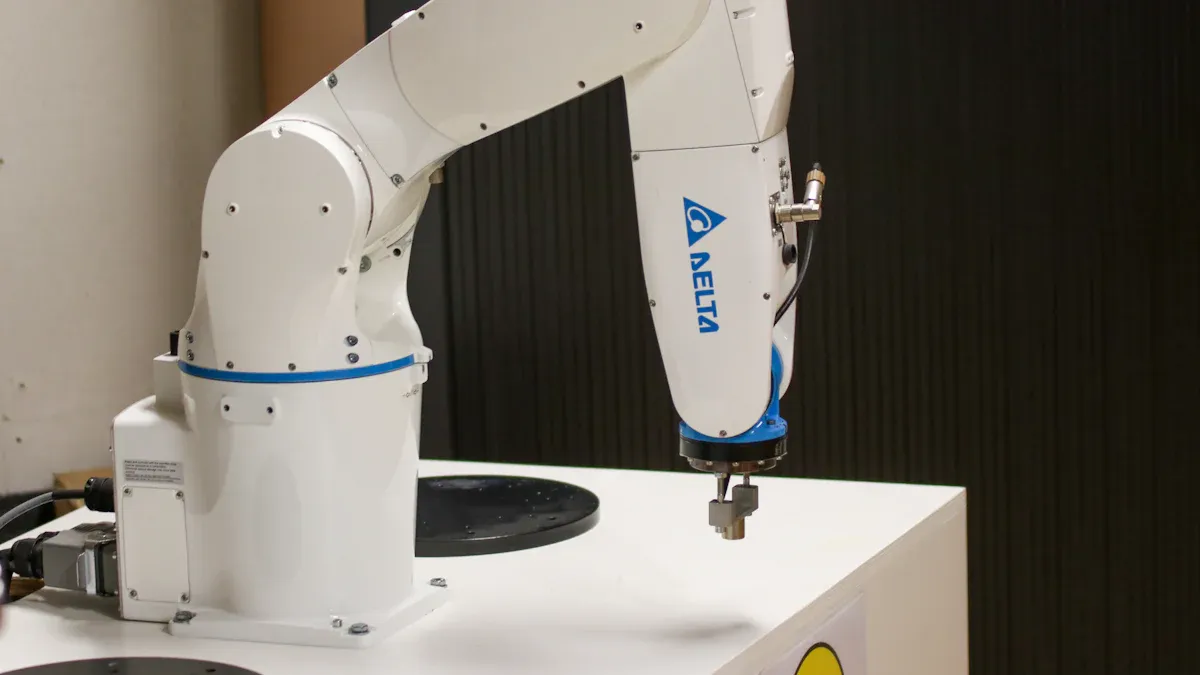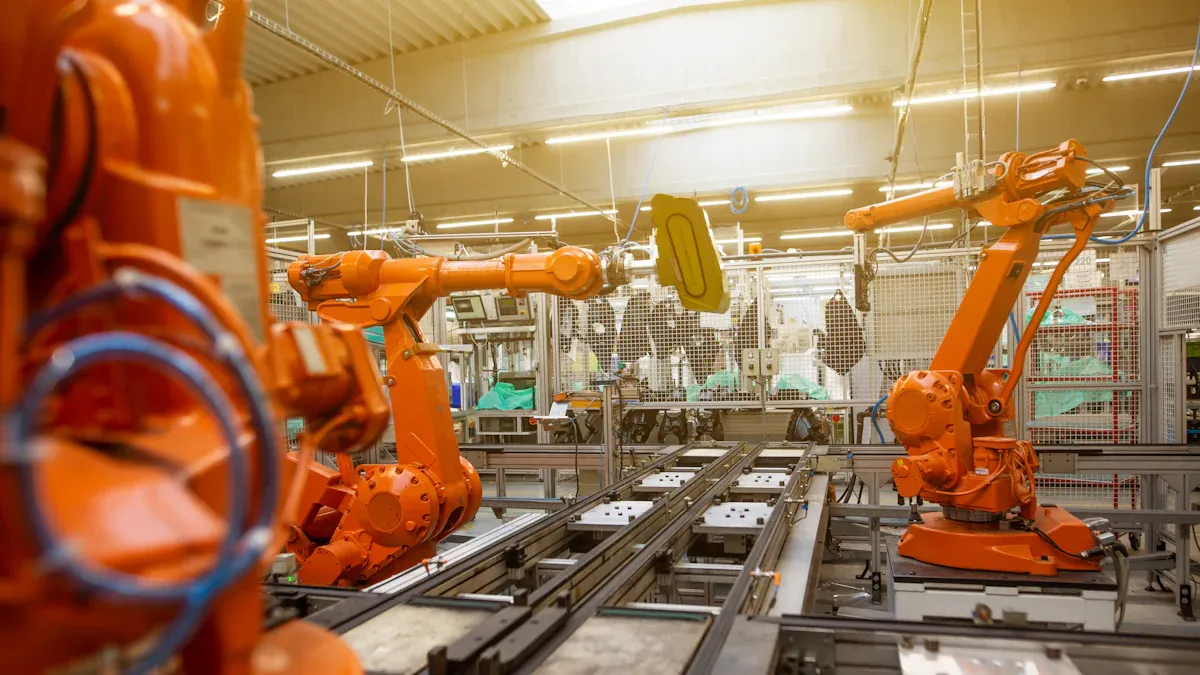- All
- Product Name
- Product Keyword
- Product Model
- Product Summary
- Product Description
- Multi Field Search
Views: 0 Author: Site Editor Publish Time: 2025-10-20 Origin: Site












If you want to know the price of a robot arm, you might be shocked by how much the prices change. You can get simple models for about $195. Advanced industrial arms can cost more than $70,000. Some cost even more! Here is a quick look at real prices:
| Model Description | Price Range |
|---|---|
| Koch v1.1 (Education/Prototyping) | ~$195 |
| Bront BRTIRPZ1825A 4Axis Heavy Duty Robot | $3,300 - $3,800 |
| Factory Robot Four-axis Palletizer | $10,000 - $13,000 |
| RO1 (Industrial Automation) | $37,000 |
| UR20 (Collaborative, Electronics) | $50,000 - $70,000 |
| 3D Carving Robotic Arm KUKA 7 Axis | $40,000 - $72,000 |
You will see choices for schools, hobbyists, and factories. The price of a robot arm mostly depends on what the robot arm can do and where you want to use it.
Robot arm prices are very different. Some basic models cost $195. Some advanced industrial arms cost over $500,000.
Think about what you need. The best robot arm depends on its payload, reach, and features. These things change the price.
There are hidden costs. Maintenance, software, and training can make owning a robot arm much more expensive.
You can look at refurbished models or leasing. These options can help you save money and still get the technology you want.
Always try to negotiate prices with vendors. You might get discounts or extra services that make your purchase better.

When you look at the price of a robot arm, you will see a huge range. Some robot arms cost less than a new phone, while others cost as much as a house. The robot arm cost depends on what you need it to do. Let’s break down the typical price ranges for different types of robot arms so you can see where your needs might fit.
| Type of Robot Arm | Typical Price Ranges |
|---|---|
| Educational/Hobby | $200 – $800 |
| Entry-Level | $500 – $5,000+ |
| Collaborative | $25,000 – $75,000 |
| Industrial | $30,000 – $500,000+ |
If you want to start with a low-cost robot arm, you have many choices. These arms work well for students, hobbyists, and small businesses. You can use them for learning, simple tasks, or even light assembly work. Some popular models include the Kikobot C1, Mycobot 280, and DOBOT Magician. These robot arms give you a taste of automation without a huge investment.
Here’s a quick look at some entry-level robot arm prices:
| Robotic Arm | Price | Description |
|---|---|---|
| Kikobot C1 | $480 | A 6-axis cobot for education and small business. |
| Mycobot 280 | $600 | A compact 6-axis arm for beginners and hobbyists. |
| DOBOT Magician | $1,500 | A 4-axis robot arm for schools, with features like writing, drawing, and 3D printing. |
You can find some educational robot arms for as low as $200, but most entry-level models cost between $500 and $5,000. If you want a robot arm for your classroom or home project, this is the price range you should expect. The price of a robot arm in this group stays low because these models have lighter payloads and simpler controls.
Tip: If you want to try robotics without spending a lot, start with an entry-level or educational model. You can always upgrade later!
When you need a robot arm for a factory or a big project, you will see much higher prices. The industrial robot arm cost depends on size, strength, and features. Some basic industrial robot arms start at $5,000, but most cost much more. If you need a robot arm that can lift heavy things or work fast, the price goes up quickly.
Here are some common price points for industrial robot arms:
| Type of Robot Arm | Price Range |
|---|---|
| Basic Industrial Arms | $5,000 – $15,000 |
| Advanced 6-Axis Arms | $30,000 – $100,000 |
| Custom or Heavy-Duty Arms | Over $100,000 |
Basic robot arms for simple tasks: $5,000 to $15,000
Advanced robot arms with more movement: $30,000 to $80,000
Custom robot arms for special jobs: over $100,000
Some examples include small SCARA robots (below $10,000), industrial 6-axis arms ($30,000–$100,000), and heavy-duty vertical arms (starting at $40,000). If you want a robot arm for welding, painting, or assembly in a factory, you will likely pay between $30,000 and $500,000. The price of a robot arm in this category reflects its power and flexibility.
Note: The industrial robot arm cost can go even higher if you need special features or custom designs. Some large robots can cost more than $400,000.
Collaborative robot arms, or cobots, work safely next to people. These arms are popular in factories and workshops because they are easy to program and move. The price of a robot arm in this group usually falls between $25,000 and $75,000.
Here are some real-world collaborative robot arm prices:
| Model | Price |
|---|---|
| Cobot Arm 1 | $55,000 |
| Cobot Arm 2 | $63,000 |
| Cobot Arm 3 | $27,300 |
Most collaborative robot arms cost between $45,000 and $70,000. These arms are more expensive than entry-level models, but they offer more safety and flexibility. If you want a robot arm that can work with people and handle many tasks, a cobot might be the right choice.
Remember: Collaborative robot arms cost more than hobby models, but they can save you money in the long run by working safely with your team.
When you compare robot arm prices, always think about what you need the robot to do. The cost of a robot arm changes a lot based on its type and features. If you know your needs, you can find the best robot arm cost for your project.

When you look at robot arms, you might wonder why prices change so much. The answer comes down to a few key things. Let’s break down the main cost factors so you know what to watch for.
Payload means how much weight the robot arm can lift. Reach is how far the arm can stretch. If you want a robot arm to move heavy boxes or reach across a big table, you’ll need a model with higher payload and longer reach. These features make the robot arm stronger and bigger, but they also make it more expensive.
Tip: Think about what you need your robot arm to pick up and how far it needs to move. Don’t pay for extra strength or reach if you don’t need it!
The axis count tells you how many ways the robot arm can move. More axes mean more flexibility. For example, a 4-axis arm can move up, down, left, and right. A 6-axis arm can twist and turn in more directions. If you want your robot arm to do complex jobs, like assembling small parts or painting, you’ll need more axes. More axes usually mean a higher price.
| Axis Count | What It Can Do | Typical Use |
|---|---|---|
| 4 | Basic moves | Simple pick-and-place |
| 6 | Complex moves | Assembly, welding |
| 7+ | Extra flexibility | Special tasks |
Robot arms come with different features. Some have touch screens, safety sensors, or special grippers. Others can connect to Wi-Fi or use cameras to “see” objects. Each extra feature adds to the price. You should decide which features you really need.
Note: Fancy features sound cool, but you might not need them for your project.
Integration means how well the robot arm works with your other machines or software. If you want your robot arm to talk to your computer or factory system, you might need extra parts or software. This can add to the cost. Some robot arms are easy to set up, while others need experts to help.
If you keep these cost factors in mind, you can find a robot arm that fits your needs and your budget.
When you look at robot arms, the price tag might seem clear. But there are hidden costs you need to know about. These extra expenses can surprise you if you only focus on the sticker price. Here’s a quick table to show what you might face:
| Cost Factor | Description |
|---|---|
| Initial Purchase Price | The base cost of the robot arm. This is often much lower than the real total. |
| Maintenance Costs | Money you spend to keep your robot arm working well. |
| Integration Costs | What you pay to connect the robot to your other machines or systems. |
| Operational Costs | Costs for running the robot, like power and labor. |
| Total Estimated Cost | You should plan for at least three times the initial price for everything. |
You might think you can just plug in your robot arm and start using it. Most of the time, you need to pay for setup. This can include mounting the arm, wiring, and making sure it works with your other equipment. Even cheap robot arms can have installation fees. Sometimes, you need a professional to help, which adds to your bill.
Robot arms need care to keep working. You will have to pay for regular check-ups, repairs, and sometimes new parts. Cheap robot arms might need more fixes if they use lower-quality parts. If you skip maintenance, your robot arm could break down and cost even more to fix later.
Tip: Plan for yearly maintenance costs. This helps you avoid big surprises.
Most robot arms need special software to run. You might have to buy a license or pay for updates. Some cheap robot arms come with basic software, but you may want better features. Upgrading or adding new programs can raise your total cost.
You and your team need to learn how to use the robot arm. Training can take time and money. Even if you buy cheap robot arms, you still need to know how to use them safely. Some companies offer free lessons, but others charge extra.
Remember: Always budget for these hidden costs. The real price of a robot arm is more than what you see at first. If you plan ahead, you can avoid surprises and get the most from your investment.
You don’t always need a brand-new robot arm. Refurbished and used models can help you save a lot of money. Many companies check and repair these arms before selling them again. You get a working robot arm for less cash. Sometimes, you even get a short warranty. If you want to try robotics or need a backup arm, this is a smart choice.
Tip: Ask the seller for a test run or a video demo before you buy a used robot arm. You want to see it working!
Leasing gives you a robot arm without a big upfront payment. You pay a monthly fee and use the robot for your project. This works well if you only need the arm for a short time or want to test it before buying. Some companies offer lease-to-own deals, so you can buy the robot later if you like it.
Benefits of Leasing:
Lower starting cost
Easy upgrades
No long-term commitment
| Leasing Option --- Monthly Cost --- Best For | |---|---|---| | Short-Term Lease --- $200 – $1,000 --- Projects, trials | | Lease-to-Own --- Varies --- Long-term use |
Picking the right model saves you money. You don’t need the biggest or fanciest robot arm. Think about what you want the robot to do. Choose a model with just enough power and features. If you buy more than you need, you waste money.
Note: Write down your main tasks. Match them to the robot arm’s specs. This helps you avoid paying for extras you won’t use.
You can often get a better price if you ask. Vendors expect you to negotiate. You might get discounts, free training, or extra parts. Don’t be shy! Ask about deals, bundles, or price matching.
Compare prices from different sellers
Ask for a quote in writing
Request free shipping or setup
Pro Tip: The first price is rarely the final price. Speak up and save!
You now know robot arms can cost anywhere from $200 to over $500,000. The price depends on what you need—like payload, reach, and features. Don’t forget about hidden costs such as installation, software, and training.
Always check for refurbished or leased options.
Pick the right model for your needs.
Ask for discounts or bundles.
Take your time, do your research, and set a smart budget before you buy. You’ll make a better choice and save money!
You can buy a basic robot arm for $200 to $800. These models work well for learning and small projects. You don’t need a big budget to get started.
Yes! Many entry-level robot arms fit on a desk. You can use them for coding, 3D printing, or simple tasks. Just check the size and safety features before you buy.
Most robot arms come with their own software. Some need extra programs for advanced features. Always ask the seller what’s included so you don’t get surprised.
A robot arm can last five to fifteen years. Regular maintenance helps it work longer. If you take care of your robot arm, you’ll get more value.
You can upgrade some robot arms with new parts or software. Entry-level models have fewer options. Industrial arms often support more upgrades. Check with the manufacturer for details.